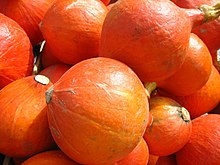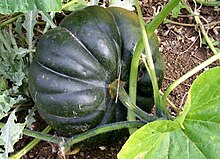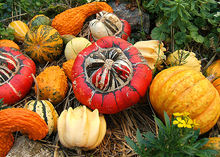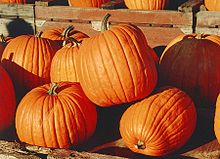Pumpkins
| Pumpkins | ||||||||||||
|---|---|---|---|---|---|---|---|---|---|---|---|---|

Patisson plant ( Cucurbita pepo var. Patisson ) |
||||||||||||
| Systematics | ||||||||||||
|
||||||||||||
| Scientific name | ||||||||||||
| Cucurbita | ||||||||||||
| L. |

The pumpkins ( Cucurbita ) constitute a genus from the family of the Cucurbitaceae (Cucurbitaceae).
Five species are cultivated: Cucurbita argyrosperma , fig leaf pumpkin ( Cucurbita ficifolia ), giant pumpkin ( Cucurbita maxima ), musk pumpkin ( Cucurbita moschata ) and garden pumpkin ( Cucurbita pepo ).
history
The different species were largely domesticated independently for the same use . The time was long around 5000 BC. BC assumed what would be after Phaseolus and Capsicum . However, recent finds of domesticated pumpkin seeds are dated 8000 to 10,000 BC. To date. Pumpkins were grown in the Moxos Plain over 10,000 years ago. The garden gourd was domesticated in Mexico and the southern United States, the musk gourd in Central America, and the giant gourd in South America. It is believed that the nutritious seeds were originally used as they are free from bitter substances , while all wild forms have bitter fruits. The selection of non-bitter forms also made it possible to use it as a vegetable. Already in pre-Columbian times there was a great variety of varieties. Seeds came to Europe early on, where pumpkins were popularly grown.
features
The pumpkins are annual , rarely perennial , herbaceous plants . Most species, including all cultivated ones, are more mesophytic and have a thread-like root system ; only a few species are xerophytic and have an enlarged root system. The stems are usually prostrate or climbing. The tendrils are three to seven times branched.
They are monoecious ( monoecious ). The flowers stand individually on long stalks in the leaf axils. The chalice is bell-shaped and has five lobes. The crown is of 6 to 10 cm length in both sexes almost the same size, campanulate, fünfzipfelig by the maximum divided to half. The flower color is golden yellow, Cucurbita okeechobeensis has cream colored flowers. The male flowers appear to have three stamens , but 2 + 2 + 1 are fused. The stamens are free, the anthers have grown together to form a column. The female flowers have small staminodes and a three to five-fold ovary below . One pen is short and carries three to five bilobed scars . In a discus and at the base of hypanthium is nectar produced.
The fruits are three- to five-fold, very large and multi-seeded carrot berries . Shape, size and color vary greatly depending on the cultivated variety. In the wild forms, the pericarp is hard and lignified and remains intact for a long time. After a long period of storage, essentially dry pericarp, stem and seeds remain. Dry fruits are also buoyant. The seeds are flat, ovate to elliptical in outline and have a thickened edge.
The number of chromosomes in the genus is 2n = 40. It is believed that this is an ancient polyploidy .
distribution

The genus is originally native to America only. The domesticated species are cultivated today in warm areas around the world.
The locations range from hot dry areas to cool cloud forests. All species are sensitive to frost. Most species grow in hot, lowland areas with pronounced rainy and dry seasons. They need high levels of sun exposure. Germination or budding from the storage organs takes place at the beginning of the rainy season. The more mesophytic species usually grow in deciduous thorn bush forests. Furthermore, they often grow in naturally disturbed locations such as on river banks and in the floodplains of rivers. The sand of coastal dunes, waterlogged lowland soil or gravel soil at high sea levels can serve as the substrate.
Systematics





The genus is placed within the family in the subfamily Cucurbitoideae, Tribe Cucurbiteae. Her sister taxon is Peponopsis . Together with Peponopsis and Polyclathra it forms a group separate from the other genera of the tribe.
There are around 15 species in the genus Cucurbita :
- Cucurbita argyrosperma C. Huber
-
Cucurbita digitata complex, with those sometimes only classified as subspecies
- Cucurbita digitata A. Gray
- Cucurbita palmata S. Watson
- Cucurbita cylindrata L.H. Bailey
- Cucurbita cordata S. Watson
- Cucurbita ecuadorensis H.C. Cutler & Whitaker
- Fig Leaf Pumpkin ( Cucurbita ficifolia Bouché )
- Cucurbita foetidissima Kunth
- Cucurbita lundelliana L.H. Bailey
- Giant pumpkin ( Cucurbita maxima Duchesne ): this subheading also includes the Hokkaido pumpkin
- Musk gourd ( Cucurbita moschata Duchesne )
- Cucurbita okeechobeensis (Small) LH Bailey . With two subspecies.
- Cucurbita pedatifolia L.H. Bailey
- Garden pumpkin ( Cucurbita pepo L. ): this also includes Styrian oil pumpkin , zucchini and gem squash
- Cucurbita radicans Naudin
use
Five species of the genus Cucurbita are cultivated by humans . Garden pumpkin , giant pumpkin and musk pumpkin are the more important ones; Cucurbita argyrosperma and the fig leaf pumpkin are only of regional importance. The five species can be distinguished by their fruit and leaf characteristics, which are indicated in the respective articles.
Representatives of other genera of the Cucurbitaceae family are also often referred to as "pumpkins" and are treated under use in the family article .
While the range of pumpkins was limited to America in pre-Columbian times , they have been cultivated in warm regions around the world since the 16th century. There is only a very limited difference in cultivation between the garden pumpkin and the giant pumpkin ; The forms of use are more important here:
- Pumpkins are mainly used as boiled, fried or baked vegetables . Even the pre-Columbian indigenous population had dried the pumpkin pulp, cut into strips, and made it durable in this way.
- In the United States is traditionally about specific events (eg. As Thanksgiving ) Pumpkin Pie ( Pumpkin Pie eaten).
- The use of pumpkins to make pumpkin soup is also common .
- Pumpkin pads are required for cucumber refinement .
- More rarely, the tips of the shoots , flowers and leaves of the pumpkin are used as vegetables.
- Pumpkin seeds , on the other hand, are used quite often, roasted as a snack or to make pumpkin seed oil . For this purpose, there are various breeds of oil pumpkins without seed pods, such as B. the Styrian oil pumpkin .
- Furthermore, different parts of the pumpkin were and are used in folk medicine .
- Today, far beyond the area of origin, it is known and widespread is the custom of Halloween hollowing pumpkins and turn them into lanterns. They even have their own variety of Jack-O'-Lantern.
- Another common practice is to grow pumpkins that are as large as possible. The previous world record of 1,054.01 kg was set on October 12, 2014. The current world record pumpkin weighed 1190.5 kg and was awarded on October 2, 2016 in Ludwigsburg.
- The pumpkin throwing is used only for entertainment .
World production
In 2016 the world harvest was 26.5 million tons. The country with the largest pumpkin production in the world was China , which produced 29.4% of the world's harvest. The ten largest producing countries brought in around 72.4% of the world harvest.
The ten largest pumpkin producers in 2016 were:
| rank | Country of production | Amount in t |
|---|---|---|
| 1 |
|
7,789,427 |
| 2 |
|
5,073,678 |
| 3 |
|
1,224,711 |
| 4th |
|
1,209,810 |
| 5 |
|
1.005.150 |
| 6th |
|
677.048 |
| 7th |
|
603.325 |
| 8th |
|
580.188 |
| 9 |
|
518,862 |
| 10 |
|
489,999 |
| remaining countries | 7,314,418 | |
| world | 26,486,616 |
The pumpkin in common German names
Most of the German-speaking trivial names originally referred to the bottle gourd , a species also belonging to the gourd family, which has been known outside America since ancient times: Bäbenen, Bebirna ( Old High German ), Chörbse ( St. Gallen ), Churbez ( Middle High German ), Churbiz (Old High German), Corbess (Middle High German), Corbicz (Middle High German), Corbs (Middle High German), Couwörden, Curbiz (Old High German), Fläschen ( Altenahr , Hunsrück ), Flaskenappel ( East Friesland ), Kerbes ( Siebenbürgen ), Kirbes (Middle High German), Kirbes (Middle High German) Middle High German), Kirbs (Middle High German), Kirns ( Eifel near Bertrich ), Körbis, Körbitzen ( Magdeburg Bible from 1578), Körbs ( Mecklenburg , Pomerania ), Körwitz ( Hamburg ), Korbes (Middle High German), Korbess (Middle High German), Korbis (Middle High German ), Korbiz (Middle High German), Korvase, Korvese, Korvesege, Korvesen ( Lübeck Bible), Korwicze (Middle High German), Koyrbiss ( Middle Low German ), K reps, Kürbeiz (Middle High German), Kürbiss (Middle High German), Kürbs ( Rhine ), Kurbis (Middle High German), Kurbis (Middle High German), Kurbiss (Middle High German) and Kurbiz (Middle High German), Kurbsch, Kurbesa, Kurbeta, Kyrbs ( Middle High German), Kyrbss (Middle High German), Kyrpss (Middle High German), Malune (St. Gallen, Bern ), Plutz, Plutzer ( Austria ) and Torkappel ( Altmark ).
The pumpkin in English
In the English language in particular, there is a confusing multitude of common names for the pumpkin that only partially correspond to the botanical taxa . The best known examples are:
squash
When squash pumpkins are referred originally used raw.
A distinction is still made - especially in the USA - between summer squash ('summer pumpkin') and winter squash ('winter pumpkin'):
- Summer squash
- Summer squashes are varieties that are harvested when immature and cannot be stored. These varieties mostly belong to the type of garden pumpkin and are usually boiled or fried.
- Winter squash
- Winter squashes are varieties that are harvested when they are ripe (i.e. in autumn) and can be stored well into winter. Such varieties can be of all types of pumpkin and are usually boiled or baked.
Outside of the United States, different names exist for summer and winter squashes.
Pumpkin
As a Pumpkin in the United States varieties are indicated by large, round fruits to cakes, pumpkin lanterns ( jack-o'-lantern are processed) and cattle feed. They are also used as table vegetables.
The varieties of musk and giant squash known in the United States as winter squashes are z. B. in India also referred to as pumpkins .
Cushaw
Cushaw are called winter squashes with a curved fruit set. They are used for baking or as animal feed.
Gourd
As gourds pumpkins are usually referred to, which does not serve food purposes; but also species of other pumpkin genera , such as. B. the bottle gourd , the bottle gourd ( Lagenaria siceraria ), are called in English Gourd .
ingredients
| Nutritional value per 100 g of pumpkin ( Cucurbita pepo L. ), raw | |
|---|---|
| Calorific value | 122 kJ (28 kcal) |
| water | 91.00 g |
| protein | 1.10 g |
| carbohydrates | 4.59 g |
| - fiber | 2.16 g |
| fat | 0.13 g |
| Vitamins and minerals | |
| vitamin C | 12 mg |
| Vitamin E. | 1.1 mg |
| Calcium | 22 mg |
| iron | 800.0 µg |
| magnesium | 8.0 mg |
| sodium | 3.1 mg |
| phosphorus | 92 mg |
| potassium | 304 mg |
| zinc | 200 µg |
| Examples of flavorings in pumpkins |
|---|
 Nonanol (an alcohol ) |
 Nonanal (an aldehyde ) |
 Ethyl hexanoate (an ester ) |
Pumpkins consist of over 90% water , which is why their nutritional value is low at 122 kJ per 100 grams. The content of vitamins and minerals in the pulp is also low. In the cores, however, this is higher. Pumpkin seed oil is made from pumpkin seeds and has a long shelf life due to its high tocopherol content.
Color and aroma
The color of pumpkins is mainly determined by carotenoids (e.g. α- and β-carotene), with both the concentration and the distribution of these (in the pulp and skin) being different. The flavor depends on the various pumpkin types of different materials, often alcohols , aldehydes and esters are crucial. For example, pumpkins of the Rouge variety contain mainly flavorings that consist of nine carbon atoms . In other varieties, flavorings that consist of six carbon atoms dominate (e.g. Sunny ). Jonones can also represent main aromatic components (e.g. nutmeg ). Some - especially wild pumpkins - have a bitter taste, which can be attributed to cucurbitacine .
Toxicity
Bitter-tasting pumpkin (dishes) should not be eaten. The bitter taste is caused by the poisonous bitter substances cucurbitacins, which are not changed by the cooking process and which can attack the stomach and intestinal mucosa. Especially by back-crossing (home-grown seeds) or crossing with other squash plants (zucchini), an increased content of Cucurbitacin result.
literature
- RW Robinson, DS Decker-Walters: Cucurbits . CAB International, Wallingford 1997, pp. 71-83. ISBN 0-85199-133-5 , (features, usage)
- Siegmund Seybold (Ed.): Schmeil-Fitschen interactive (CD-Rom), Quelle & Meyer, Wiebelsheim 2001/2002, ISBN 3-494-01327-6 , (features)
Web links
Individual evidence
- ↑ Dolores R. Piperno , Karen E. Stothert: Phytolith Evidence for Early Holocene Cucurbita Domestication in Southwest Ecuador . Science, Vol. 299, Feb. 14, 2003, pp. 1054-1057. doi: 10.1126 / science.1080365 .
- ↑ Umberto Lombardo, José Iriarte, Lautaro Hilbert, Javier Ruiz-Pérez, José M. Capriles, Heinz Veit: Early Holocene crop cultivation and landscape modification in Amazonia. In: Nature. 2020, doi : 10.1038 / s41586-020-2162-7 .
- ↑ Agriculture began in the Amazon 10,000 years ago. University of Bern , April 8, 2020, accessed on April 8, 2020 .
- ↑ M. Pitrat, M. Chauvet, C. Foury: Diversity, history and production of cultivated cucurbits . In: K. Abak, S. Büyükalaca: Proceedings of the First International Symposium on Cucurbits . Acta Horticultae, Volume 492, 1999, pp. 21-29. ISSN 0567-7572
- ^ Thomas C. Andres: Searching for Cucurbita germplasm: collectin more than seeds . In: N. Katzir, HS Paris: Proceedings of 7th EUCARPIA Meeting on Cucurbit Genetics and Breeding . Acta Horticulturae, Volume 510, 2000, pp. 191-198. ISBN 90-6605-852-8 .
- ↑ Alexander Kocyan, Li-Bing Zhang, Hanno Schaefer, Susanne S. Renner: A multi-locus chloroplast phylogeny for the Cucurbitaceae and its implications for character evolution and classification . Molecular Phylogenetics and Evolution, Volume 44, August 2007, pp. 553-577. doi: 10.1016 / j.ympev.2006.12.022 , full text (PDF; 381 kB).
- ^ RW Robinson, DS Decker-Walters: Cucurbits . CAB International, Wallingford 1997, p. 53. ISBN 0-85199-133-5
- ↑ [1] guinnessworldrecords.de, accessed on November 4, 2014.
- ↑ 1.2 ton pumpkin takes world record title . In: Schwäbische.de . ( schwaebische.de [accessed on October 24, 2016]).
- ↑ a b FAOSTAT production statistics , accessed on January 25, 2018 .
- ↑ Peter Dilg: Pumpkin plants. In: Lexicon of the Middle Ages . Volume V, p. 1579.
- ^ Georg August Pritzel , Carl Jessen : The German folk names of plants. New contribution to the German linguistic treasure. Philipp Cohen, Hanover 1882, p. 120 f. ( online ).
- ↑ Souci, SW, specialist, W. & Kraut, H. (2016): The composition of the food nutritional value tables . 8th edition. Stuttgart: Scientific publishing company. Pp. 818-819, ISBN 978-3-8047-5073-9 .
- ↑ a b entry on pumpkin. In: Römpp Online . Georg Thieme Verlag, accessed on November 20, 2019.
- ↑ Kreck, M. et al .: Influence of the variety on carotenoids and flavorings in pumpkin juice , Deutsche Lebensmittel Rundschau, 2004 , 100 (11) , pp. 445–452. [2] .
- ↑ Fatal poisoning by zucchini, SWR.de, August 19, 2015, accessed August 21, 2015 .



